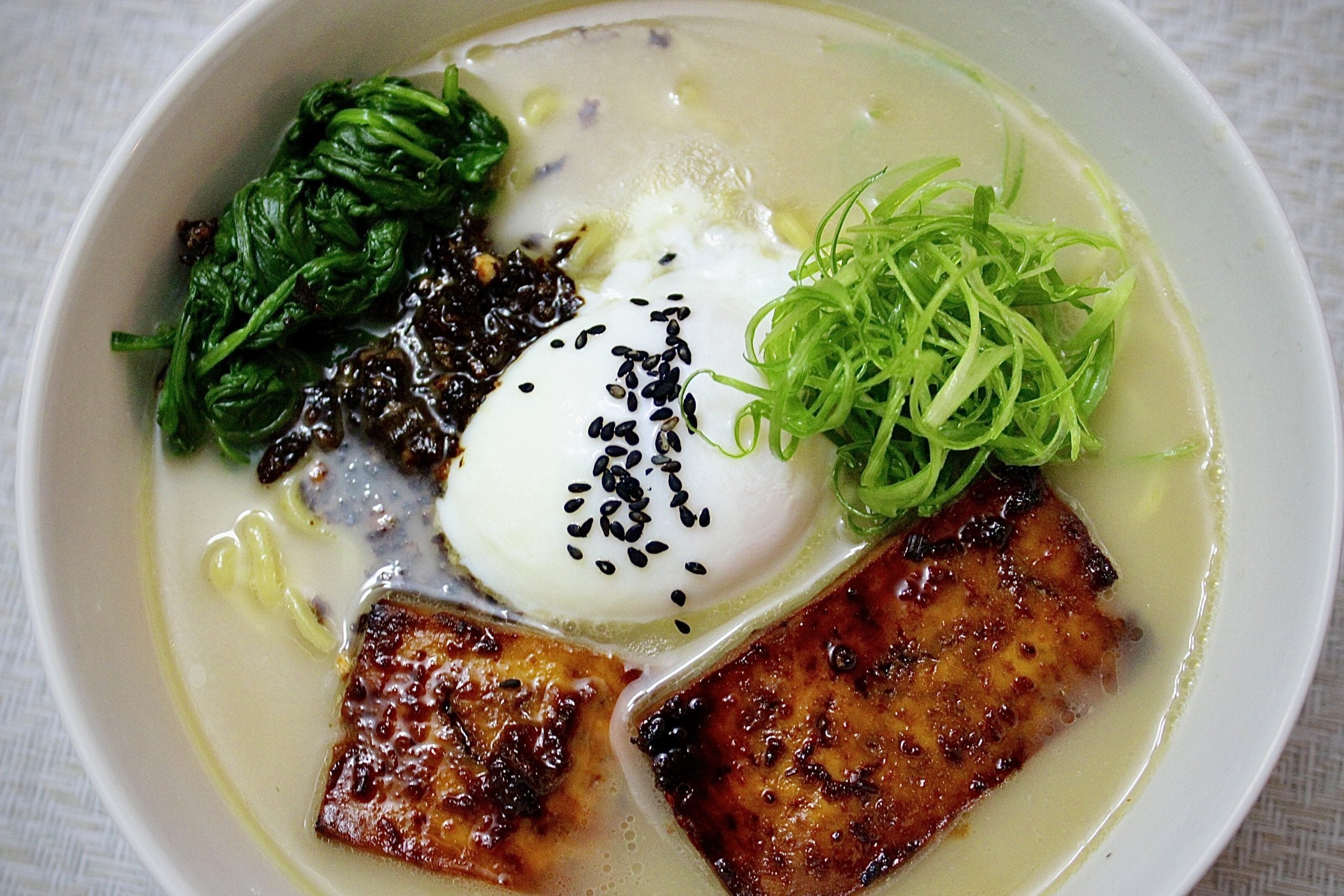
A Beginner’s Guide to Ramen #1 – Broth
By Brandon Muhawi
Senior Food Writer at Pro Home Cooks
Ramen is complicated. No, not the styrofoam cup of instant goodness, but real artisan ramen. If you haven’t had the opportunity to have real ramen, this is your sign to take a trip down to your closest ramen shop and have your mind blown. (Here’s a tip: if the shop’s menu is 95% ramen, you’re in the right spot.) There’s nothing like that first bite. If you’re anything like me, though, your appetite for good ramen is deeper than your wallet. That shouldn’t stand in your way of a good bowl of noodles. Complicated as ramen is, it’s very possible to do well at home. It’s a project, a labor of love, but it’s worth it all for that first bite.
I am by no means an expert on ramen – if anything I would consider myself a beginner. There is a deep, deep rabbit hole of information online regarding the craft of artisan ramen that I would encourage you to follow if the subject interests you. There are some phenomenal people on the internet who know much more than I do. However, I hope this quick and dirty introduction can be a sort of gateway drug into making ramen at home. This post will act not only as a brief introduction to ramen in general but go into specific terminology and techniques regarding one of the five components of ramen – the broth.
As I just stated, ramen has five crucial components. Without all five components, the bowl of ramen is incomplete. These components are:
- Noodles
- Broth/Soup
- Tare (seasoning for the broth)
- Aroma oil
- Toppings
When making ramen at home, the broth is one of the most time-consuming components. Depending on the type of ramen you are trying to make, the broth could take up to 48 hours from start to finish. Most of this time does not require active cooking on your part, but because the process is so long it’s important to set yourself up for success. A wrong turn could set you days behind.
At this point, it’s important to note that ramen is a slow, laborious product of love and care. If you make a bowl from start to finish, you will no longer wonder why prices at artisan ramen restaurants are so high. Mike has great videos on ramen-y bowls of noodles that can quickly curb that craving, but I still highly recommend trying to make a true bowl of ramen at home without shortcuts. It’s a project meal with a satisfying finish, like kombucha or sourdough, and the process becomes streamlined the more practice you have.
Back to the broth – ramen broth is unique in the fact that it is completely unseasoned. Unlike Western stocks and broths or even other noodle soups, the broth is seasoned in the bowl when combined with the tare, another component of ramen.* The goal when making the broth is to extract the maximum amount of flavor possible from the bones in hopes of having a meaty soup that holds up to the intense seasoning that is added in the bowl.
*There are rare exceptions to this that will be discussed in a later post.
There are two types of ramen broth: paitan (白湯 – “white hot water”) and chintan (清湯 – “clear hot water”). These rough translations are self-explanatory. Paitans are thick, rich, cloudy broths – think of your average tonkotsu ramen. Chintans are translucent, delicate, and much less rich than a paitan broth. Paitan and chintan refer solely to the physical properties of the soup and not the types of bones used.
Technique

Paitan:
Paitan broths are the result of emulsification. This means that the water of the broth has had the opportunity to combine or emulsify with the fats present in the animal product. This creates a cloudy appearance, richer texture, and a ridiculously meaty and luxurious soup. The emulsification occurs through the rapid boiling of your broth over a long period of time.
Techniques:
- Paitans are cooked at a rapid boil for a minimum of 6 hours, up to 24 hours.
- The texture is highly dependent on the amount of fat and gelatin present in the animal product you are using. For richer broths, add skin and collagen-heavy animal parts such as feet, or even chunks of skin and fat.
- Emulsification can be tricky. If your paitan separates even after hours of boiling, your ratio of water to fat may be off. Too much or too little water/fat can both lead to separation. In a pinch, an immersion blender can help force emulsification temporarily.
- As the bones in the pot break down, mottling the bones into smaller chunks with a wooden kitchen tool can help expose more gelatin, improving your paitan.

Chintan:
A high-quality chintan is produced when the broth is crystal clear, aside from the color imparted by the ingredients. Any semblance of cloudiness is undesirable in these delicate soups. The clarity is achieved not only through diligent skimming and straining but through a gentle cooking process.
Techniques:
-
A chintan should be cooked for a minimum of 6 hours and up to 10-12 hours at the gentlest of simmers. You should witness only a few lazy bubbles rise to the surface every second.
-
Chintan can still have a pleasant and rich texture, as collagen and gelatin can be extracted from the bones without clouding the soup.
Bones

It’s not impossible to create a delicious plant-based ramen, but for the purposes of this guide, I am going to focus on ramen made with animal products. Here are some general tips and rules to follow regarding the bones for your ramen.
-
Weigh your bones. A good ratio to start with for your broth is a 1:2 ratio of bones to water by weight. For example, 3 lbs of bones should be boiled in 6 lbs of water.
-
Pork and chicken bones are the most common bones used in ramen broth, but products such as beef and duck also work very well. Combinations of bones are very common, such as both pork and chicken.
-
Bones should be properly prepared before the long boil. Here are different techniques:
-
Always rinse and lightly scrub the bones under cold running water.
-
Soak bones in water overnight in the refrigerator and discard the soaking water. This process helps remove impurities from the bones and is especially helpful in producing a clean, white, paitan broth or clear chintan.
-
Blanching bones in rapidly boiling water for 5-10 minutes is another way to remove impurities and funky flavors. Rinse/scrub bones after blanching and use fresh water for the broth.
-
Roasting bones is uncommon but not unheard of (Momofuku Noodle Bar’s original recipe uses roasted pork bones). Roasted bones lend themselves to chintan broths, as they impart a unique flavor and unique color to the soup.
Aromatics
Unlike Western broths where aromatics are often used to impart flavor to the broth, the utilization of aromatics in ramen broth is truer to the definition. Aromatics are added with the goal of imparting the aroma of the ingredients to the broth. After boiling bones for the better part of a day, the meaty flavors should very much be at the forefront. Aromatics are helpful in covering up some of the funky notes that come from the bones, replacing them with pleasant vegetal aromas. Here are some general tips:
-
Aromatics should only be added in the last 45-60 minutes of cooking the broth. This goes for both paitan and chintan broths. Any longer and the ingredients start to break down, adding unwanted cloudiness/color to a broth and causing many of the aromas to dissipate.
-
Save your strongest ingredients for the aromatic oil. Ingredients like garlic and ginger will complement your bowl beautifully but are more noticeable within other components, such as the aroma oil or toppings. Feel free to use them if you’d like, they will always add depth to the broth. However, subtle aromatics such as scallions, onions, cabbage, or dried mushrooms can be just as effective.
A Note On Dashi

Dashi is a seafood-y stock fundamental to Japanese cuisine. To make a bowl of ramen, chances are you will make a dashi either as part of the broth, tare, or both. Paitans usually implement the dashi into the tare, while chintans may have dashi present in either component. If you’re interested in adding some extra umami to a chintan broth, you can build a dashi and use it as the liquid base for your broth. The most common dashi is made from konbu (dried kelp) and katsuobushi (smoke-dried tuna), but sourcing quality katsuobushi can be difficult and it’s a finicky ingredient, to begin with. A shiitake dashi is much more forgiving, and the quality of dried shiitakes doesn’t vary quite as much as katsuobushi.
Two easy ways to incorporate a shiitake dashi into your broth are:
- Leave a piece of dried konbu and a handful of shiitakes in a pot of water overnight. Use this liquid as the base for your broth.
- Simmer dried konbu and shiitakes in your stockpot for 30-40 minutes. Remove dashi components and add already prepped bones.
Make a Broth

This post will contain no “recipe” in the traditional sense but serves to guide a beginner through the process of making a delicious ramen broth. That being said, here is an example of what the process might look like for a tori paitan, a very beginner-friendly broth.
-
Chicken feet are trimmed and cleaned.
-
Chicken carcass/backs and feet are covered with cold water and left to soak in the fridge overnight.
-
The next day, bones are strained and rinsed.
-
Bones are blanched in boiling water for 5 minutes then strained and rinsed.
-
Bones are added back to a clean pot with fresh water at a 1:2 ratio by weight. Pot is brought to a rolling boil.*
-
The broth should be skimmed of any scum every 15-20 minutes for the first hour or two. Very fine white foam does not need to be skimmed. Stir bones to shake loose any scum stuck lower in the pot.
-
Allow broth to boil for 10-12 hours, topping off with water to keep a consistent level. Stir every now and then to prevent burning at the bottom and mottle bones with a wooden utensil.
-
Stop adding water ~2 hours before removing from the heat to allow some reduction and concentration of the broth.
-
Add aromatics (onion, scallions, garlic) 45 minutes before removing from heat.
-
Strain broth through a fine-mesh strainer. Portion and store in the fridge or freezer. If done properly, there should be no separation of fat and water and broth will solidify into gelatin in the fridge.**

*For a tori chintan, heat the pot to a lazy simmer instead of a rolling boil and cook for 6-8 hours. The rest of the process is very similar.
**Ramen broth freezes incredibly well. If you have the time, you can reduce the broth by half after straining to save room in the freezer. Just dilute your reduced broth with an equal amount of water when reheating.
Any questions or concerns? Are you an experienced ramen maker and find an error in this guide? Please feel free to email me at brandon@prohomecooks.com.
TOP ARTICLES

Sourdough Baking School
Master the art of sourdough bread baking in the most comprehensive baking class on the internet. This class features over three hours of baking content to help you start your sourdough journey.
See More
